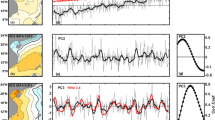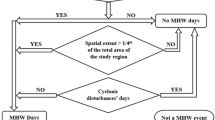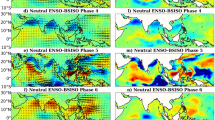Abstract
El-Nino Southern Oscillation (ENSO) is a major ocean–atmospheric coupled phenomenon in the Tropical Pacific Ocean that influences the Indian summer-time temperatures during April and May. In the current analysis, we examined the impact of ENSO on Indian heat waves. Temperature zones are identified when the maximum temperature exceeds 42°C, particularly during April and May over the Indian subcontinent. The results depicted three different regions (west Rajasthan, northwest and southwest UP, and south-central India) that experienced the frequency in days with maximum temperature above 42°C. These means are compared with those of Preceding El Nino (PEN), El Nino (EN) and Succeeding El Nino (SEN) events. It is found that PEN and SEN years experienced high positive anomalies. It can be seen that an increase in surface temperatures and heat waves are closely associated with the strengthening of north-westerlies and reduction of geopotential height at 500 hPa level, reduction of soil moisture and increase of sea surface temperatures (SST) during PEN and SEN events. The results also show that the variations in temperature and heat waves over northeast India are different from the rest of India during EN and SEN years. The three maximum temperatures regions of (1) west Rajasthan, (2) east Uttar Pradesh, and (3) Vidarbha, are identified based on both the magnitude and frequency days of above 42°C maximum temperatures. The spectrum analysis is performed for the monthly time series of the days exceeding daily surface maximum temperature 42°C for the three regions and identified the dominant periodicities with 2.2–2.8 and 3.3–8.5 years, which could be endorsed to ENSO and QBO frequencies.













Similar content being viewed by others
References
Alexander L V, Zhang X, Peterson T C, Caesar J, Gleason B, Tank A K et al. 2006 Global observed changes in daily climate extremes of temperature and precipitation; J. Geophys. Res., 111, https://doi.org/10.1029/2005JD006290.
Andersen O B, Seneviratne S I, Hinderer J and Viterbo P 2005 GRACE derived terrestrial water storage depletion associated with the 2003 European heat wave; Geophys. Res. Lett. 32(18) L18405, https://doi.org/10.1029/2005GL023574.
Barrodale I and Erickson R 1978 Algorithms for least-squares linear prediction and maximum entropy spectral analysis. Part I: Theory; Geophysics 45 420–432, https://doi.org/10.1190/1.1441091.
Bhalme H N, Mooley D A and Jadhav S K 1983 Fluctuations in the drought/flood area over India and relationships with the southern oscillation; Mon. Weather Rev. 111 8694, https://doi.org/10.1175/1520-0493(1983)111%3c0086:FITDAO%3e2.0.CO;2.
Brionnimann S 2007 Impact of El Nino-Southern Oscillation on European climate; Rev. Geophys. 45 3, https://doi.org/10.1029/2006RG000199.
Cai W, Santoso A, Wang G et al. 2015 ENSO and greenhouse warming; Nat. Clim. Change 5 849–859, https://doi.org/10.1038/nclimate2743.
Chase T N, Wolter K, Roger A, Pielke Sr and Rasool I 2006 Was the 2003 European summer heat wave unusual in a global context?; Geophys. Res. Lett. 3 L23709, https://doi.org/10.1029/2006GL027470.
Chaudhury S K, Gore J M and Sinha Ray K C 2000 Impact of heat waves over India; Curr. Sci. 79 153–155, https://www.jstor.org/stable/24103439.
Coumou D, Robinson A and Rahmstorf S 2013 Global increase in record-breaking monthly-mean temperatures; Clim. Change 118(3–4) 771–782, https://doi.org/10.1007/s10584-012-0668-1.
Coumou D and Rahmstorf S 2012 A decade of weather extremes; Nat. Clim. Change 2 491–496, https://doi.org/10.1038/nclimate1452.
Cowan T, Purich A, Perkins S, Pezza A, Boschat G and Sadler K 2014 More frequent, longer, and hotter heat waves for Australia in the twenty-first century; J. Clim. 27 5851–5871, https://doi.org/10.1175/JCLI-D-14-00092.1.
De U S and Mukhopadhyay R K 1998 Severe heat wave over the Indian subcontinent in 1998, in perspective of global climate 1998; Curr. Sci. 75 1308–1311, https://www.jstor.org/stable/24101015.
Della-Marta P M, Haylock M R, Luterbacher J and Wanner J 2007 Doubled length of western European summer heat waves since 1880; J. Geophys. Res. 112 D15103, https://doi.org/10.1029/2007JD008510.
Dodla V B, Satyanarayana G C and Desamsetti S 2017 Analysis and prediction of a catastrophic Indian coastal heat wave of 2015; Nat. Hazards 87 395–414, https://doi.org/10.1007/s11069-017-2769-7.
Firpo M A F, Sansigolo C A and Assis S V 2012 Climatology and seasonal variability of the number of warm and cold waves in Rio Grande do Sul associated to ENOS; Rev. Bras Meteorol. 27 95–106, https://doi.org/10.1590/S0102-77862012000100010.
Fischer E M, Seneviratne S I, Vidale P L, Luthi D and Schar C 2007 Soil moisture–atmosphere interactions during the 2003 European Summer heat wave; J. Clim. 20 5081–5099, https://doi.org/10.1175/JCLI4288.1.
Fischer E and Schar C 2008 Future changes in daily summer temperature variability: Driving processes and role for temperature extremes; Clim. Dyn. 33 917–935, https://doi.org/10.1007/s00382-008-0473-8.
Fischer E M and Schar C 2010 Consistent geographical patterns of changes in high-impact European heatwaves; Nat. Geosci. 3 398–403, https://doi.org/10.1038/ngeo866.
Garcia-Herrera R, Díaz J, Trigo R M, Luterbacher J and Ficher E 2010 A review of the European summer heat wave of 2003; Crit. Rev. Environ. Sci. Technol. 40 267–306, https://doi.org/10.1080/10643380802238137.
Halpert M S and Ropelewski C F 1992 Surface temperature patterns associated with the southern oscillation; J. Clim. 5 577–593, https://doi.org/10.1175/1520-0442(1992)005%3c0577:STPAWT%3e2.0.CO;2.
Ham Y G 2018 El Niño events will intensify under global warming; Nature 564(7735) 192–193, https://doi.org/10.1038/d41586-018-07638-w.
Hastenrath S and Heller L 2006 Dynamics of climatic hazards in Northeast Brazil; Quart. J. Roy. Meteorol. Soc. 103 77–92, https://doi.org/10.1002/qj.49710343505.
Hauser M, Orth R and Seneviratne S 2016 Role of soil moisture vs. recent climate change for the 2010 heat wave in western Russia; Geophys. Res. Lett. 43 2819–2826, https://doi.org/10.1002/2016GL068036.
Hoell A, Funk C, Zinke J and Harrison L 2017 Modulation of the southern Africa precipitation response to the El Nino Southern Oscillation by the subtropical Indian Ocean Dipole; Clim. Dyn. 48(7) 2529–2540, https://doi.org/10.1007/s00382-016-3220-6.
Holmes C R, Woollings T, Hawkins E and de Vries H 2015 Robust future changes in temperature variability under greenhouse gas forcing and the relationship with thermal advection; J. Clim. 29 2221–2236, https://doi.org/10.1175/JCLI-D-14-00735.1.
Horton R M, Mankin J S, Lesk C, Ethan C and Raymond C 2016 A review of recent advances in research on extreme heat events; Curr. Clim. Change Rep. 2 242–259, https://doi.org/10.1007/s40641-016-0042-x.
Hoy A, Hansel S, Skalak P, Ustrnul Z and Bochnicek O 2017 The extreme European summer of 2015 in a long-term perspective; Int. J. Climatol. 37 943–962, https://doi.org/10.1002/joc.4751.
Kiladis G N and Diaz H F 1989 Global climatic anomalies associated with extremes in the Southern Oscillation; J. Clim. 2 1069–1090, https://doi.org/10.1175/1520-0442(1989)002%3c1069:GCAAWE%3e2.0.CO;2.
Kim M, Lau W K M, Kim K, Jeong S, Kim Y and Lee W 2016 Amplification of ENSO effects on Indian summer monsoon by absorbing aerosols; Clim. Dyn. 46 2657–2671, https://doi.org/10.1007/s00382-015-2722-y.
Kothawale D R and Rupa Kumar K 2005 On the recent changes in surface temperature trends over India; Geophys. Res. Lett. 32 L18714, https://doi.org/10.1029/2005GL023528.
Kushnir Y, Seager R, Ting M, Naik N and Nakamura J 2010 Mechanisms of tropical atlantic SST influence on North American precipitation variability; J. Clim. 23 5610–5628, https://doi.org/10.1175/2010JCLI3172.1.
Lhotka O and Kysely J 2015 Hot Central-European summer of 2013 in a long-term context; Int. J. Climatol. 35 4399–4407, https://doi.org/10.1002/joc.4277.
Lu R-Y and Chen R-D 2016 A review of recent studies on extreme heat in China; Atmos. Sci. Lett. 9(2) 114–121, https://doi.org/10.1080/16742834.2016.1133071.
Luo M and Lau N 2017 Heat waves in southern China: Synoptic behavior, long-term change, and urbanization effects; J. Clim. 30 703–720, https://doi.org/10.1175/JCLI-D-16-0269.1.
Mazdiyasni O, AghaKouchak A, Davis S, Madadgar S, Mehran A, Ragno E et al. 2017 Increasing probability of mortality during Indian heat waves; Sci. Adv. 3 e1700066, https://doi.org/10.1126/sciadv.1700066.
Meehl G A and Tebaldi C 2004 More intense, more frequent and longer lasting heat waves in the 21st century; Science 305 994–997, https://doi.org/10.1126/science.1098704.
Moberg A, Jones P D, Lister D, Walther A and Brunet M 2006 Indices for daily temperature and precipitation extremes in Europe analyzed for the period 1901–2000; J. Geophys. Res., 111(D22106), https://doi.org/10.1029/2006JD007103.
Naveena N, Satyanarayana G C, Bhaskar Rao D V and Srinivas D 2021a An accentuated ‘hot blob’ over Vidarbha, India, during the pre-monsoon season; Nat. Hazards 105 1359–1373, https://doi.org/10.1007/s11069-020-04357-2.
Naveena N, Satyanarayana G Ch, Dharma Raju A, Sivasankara Rao K and Umakanth N 2021b Spatial and statistical characteristics of heat waves impacting India; AIMS Environ. Sci. 8(2) 117–134, https://doi.org/10.3934/environsci.2021009.
Newman M, Alexander M A, Ault T R, Cobb K M, Deser C, Di Lorenzo E et al. 2016 The Pacific decadal oscillation, revisited; J. Clim. 29 4399–4427, https://doi.org/10.1175/JCLI-D-15-0508.1.
Nicholls N, Baek H J, Gosai A, Chambers L E, Choi Y, Collins D et al. 2005 The El Niño Southern Oscillation and daily temperature extremes in East Asia and the West Pacific; Geophys. Res. Lett. 32(16) L16714, https://doi.org/10.1029/2005GL022621.
Pai D S, Thapliyal V and Kokate P D 2004 Decadal variation in the heat and cold waves over India during 1971–2000; Mausam 55(2) 281–292.
Pai D, Smitha Nair and Ramanathan A 2013 Long term climatology and trends of heat waves over India during the recent 50 years (1961–2010); Mausam 64 585–604.
Pai D, Srivastava A and Smitha Nair 2017 Heat and cold waves over India; In: Observed climate variability and change over the Indian Region; (eds) Rajeevan M and Nayak S, Springer, Singapore, https://doi.org/10.1007/978-981-10-2531-0_4.
Parthasarathy B and Dhar O N 1974 Secular variations of regional rainfall over India; Quart. J. Roy. Meteorol. Soc. 100 245–257.
Pezza A, Rensch P and Cai W 2012 Severe heat waves in Southern Australia: Synoptic climatology and large scale connections; Clim. Dyn. 38 209–224, https://doi.org/10.1007/s00382-011-1016-2.
Philander S G H 1983 El Niño Southern Oscillation phe-nomena; Nature 302 295–301.
Rasmusson E M and Carpenter T H 1983 The relationship between Eastern Equatorial Pacific Sea surface temperatures and rainfall over India and Sri Lanka; Mon. Weather Rev. 111 517–528, https://doi.org/10.1175/15200493(1983)111%3c0517:TRBEEP%3e2.0.CO;2.
Ratnam J V, Behera S, Bishoyi R S, Rajeevan M and Yamagata T 2016 Anatomy of Indian heatwaves; Sci. Rep. 6 24395, https://doi.org/10.1038/srep24395.
Ray K, Chincholikar J R and Mohanty M 2013 Analysis of extreme high temperature conditions over Gujarat; Mausam 64(3) 467–474.
Rohini P, Rajeevan M and Srivastava A K 2016 On the variability and increasing trends of heat waves over India; Sci. Rep. 6 26153, https://doi.org/10.1002/joc.1141.
Ropelewski C F and Halpert M S 1987 Global and regional scale precipitation patterns associated with the El Niño/Southern Oscillation; Mon. Weather Rev. 115 1606–1626, https://doi.org/10.1175/1520-0493(1987)115%3c1606:GARSPP%3e2.0.CO;2.
Roxy M K, Ritika K, Terray P and Masson S 2014 The curious case of Indian Ocean warming; J. Clim. 27(22) 8501–8509.
Roxy M K et al. 2015 Drying of Indian subcontinent by rapid Indian Ocean warming and a weakening land-sea thermal gradient; Nat. Commun. 6 1–10, https://doi.org/10.1038/ncomms8423.
Rupa Kumar K, Sahai A, Kumar K, Patwardhan S, Mishra P K, Revadekar J et al. 2006 High-resolution climate change scenarios for India for the 21st century; Curr. Sci. 9 334–345.
Rusticucci M 2012 Observed and simulated variability of extreme temperature events over South America; Atmos. Res. 106 1–17, https://doi.org/10.1016/j.atmosres.2011.11.001.
Sandeep A and Prasad V S 2018 Intra-annual variability of heat wave episodes over the east coast of India; Int. J. Climatol., https://doi.org/10.1002/joc.5395.
Satyanarayana G C and Dodla D V 2020 Phenology of heat waves over India; Atmos. Res., https://doi.org/10.1016/j.atmosres.2020.105078.
Srivastava A, Rajeevan M and Kshirsagar S 2009 Development of a high resolution daily gridded temperature data set (1969–2005) for the Indian region; Atmos. Sci. Lett. 10 249–254, https://doi.org/10.1002/asl.232.
Su H, Neelin J and Chou C 2001 Tropical teleconnection and local response to SST anomalies during the 1997–1998 El Niño; J. Geophys. Res. 106 20,025–20,044, https://doi.org/10.1029/2000JD000124.
Trenberth K E 1976 Spatial and temporal variations of the Southern Oscillation; Quart. J. Roy. Meteorol. Soc. 102 639–653.
Webster P J, Magana V O, Palmer T N, Shukla J, Tomas R A, Yanai M and Yasunari T 1998 Monsoons: Processes, predictability, and the prospects for prediction; J. Geophys. Res. 103 14,451–14,510.
Wolter K, Dole R M and Smith C A 1999 Short-term climate extremes over the continental United States and ENSO. Part I: Seasonal temperatures; J. Clim. 12 3255–3272, https://doi.org/10.1175/1520-0442(1999)012%3c3255:STCEOT%3e2.0.CO;2.
Zeng X, Zuo C, Zhang Y, Ning Wang, Zheng Y and Chen C 2017 Feedback between surface air temperature and atmospheric circulation in high-temperature weather in East China: A diurnal perspective; Atmos. Sci. Lett., https://doi.org/10.1002/asl.750.
Yadav R K 2016 On the relationship between Iran surface temperature and north-west India summer monsoon rainfall; Int. J. Climatol. 36 4425–4438, https://doi.org/10.1002/joc.4648.
Zhang X, Alexander L, Hegerl G C, Jones P, Klein Tank A, Peterson T C, Trewin P and Zwiers F W 2011 Indices for monitoring changes in extremes based on daily temperature and precipitation data; Wires Clim. Change, https://doi.org/10.1002/wcc.147.
Acknowledgements
Part of this research is funded by SERB, Govt. of India under Grant No. ECRA/2016/001295. The authors acknowledge free data from European Centre for Medium-Range Weather Forecasts, India Meteorological Department, and NCEP/NCAR Reanalysis. This research is supported by Early Career Research Award, Science and Engineering Research Board, Government of India through financial support under Grant No. ECR/2016/001295.
Author information
Authors and Affiliations
Contributions
NN: Data collection, visualization, and draft preparation. GChS: Conceptualization, problem envision, methodology adoption, computation, software, visualization, data curation, validation, draft preparation and writing. KKR: Draft correction and editing. DS: Analysis and visualization. NU: Data collection and visualization.
Corresponding author
Additional information
Communicated by T Narayana Rao
Supplementary material pertaining to this article is available on the Journal of Earth System Science website (http://www.ias.ac.in/Journals/Journal_of_Earth_System_Science).
Supplementary Information
Below is the link to the electronic supplementary material.
Rights and permissions
About this article
Cite this article
Naveena, N., Satyanarayana, G.C., Rao, K.K. et al. Heat wave characteristics over India during ENSO events. J Earth Syst Sci 130, 166 (2021). https://doi.org/10.1007/s12040-021-01674-3
Received:
Revised:
Accepted:
Published:
DOI: https://doi.org/10.1007/s12040-021-01674-3




